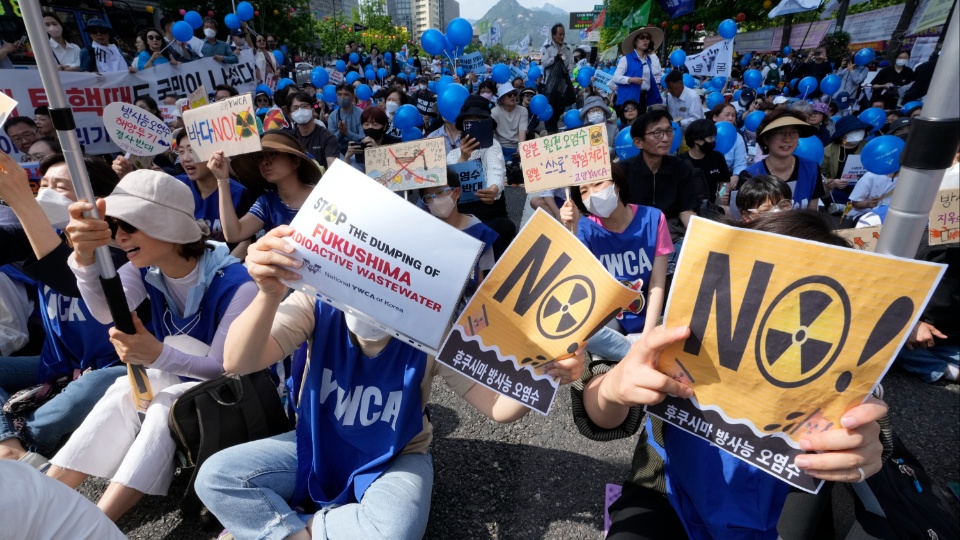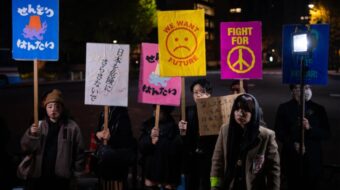
Scientists and environmentalists have raised concerns over Japan’s plan to release 1.3 million metric tons of water contaminated during the Fukushima nuclear disaster back into the Pacific Ocean.
The “treated” wastewater, which has been stored in around 1,000 tanks ever since the Fukushima Daiichi Nuclear Plant was damaged during the 2011 Tohoku earthquake and tsunami, is slated to be discharged this spring or summer.
The incident at the plant 12 years ago was the world’s worst nuclear disaster since the 1986 Chernobyl accident, and critics have questioned whether the water contaminated at the time can truly be safe.
“We don’t really know,” said Ferenc Dalnoki-Veress, an expert in low-concentration radioactivity measurements at the Middlebury Institute of International Studies in Monterey, Calif., in an interview with Science magazine in January.
The wastewater was a by-product of the process to cool the plant’s reactors, which melted down after it was affected by the earthquake and tsunami.
Large amounts of radiation were released at the time, and the water was “severely contaminated,” having come into “direct contact” with reactor fuel cores, Greenpeace East Asia said in a report on the incident.
Tokyo Electric Power, or TEPCO, the plant’s operator, has used a filtering technology called Advanced Liquid Processing System (ALPS) to try to purify the contaminated water.
The treatment was initially said to have been effective in removing most of the 62 “containments” in the water, except for tritium, an isotope that is hard to separate from water because it bonds with oxygen.
For years, tritium, which emits a low level of radiation and only poses a risk to humans in large doses, was the focus of the cleanup effort. But then in 2018, TEPCO admitted 80% of its “treated” water contained other dangerous radionuclides as well, including cesium, cobalt, lithium, and strontium, which far exceeded safe levels for release back into the ocean.
In 2020, TEPCO reported that 72% of the water in its tanks needed to be repurified. Now, experts are asking whether the water in the tanks has really been fully cleansed.
Dalnoki-Veress said TEPCO has only analyzed small amounts of water from a quarter of its tanks and measured concentrations of tritium and a limited number of other radionuclides.
Ken Buesseler, a senior scientist at the United States’ Woods Hole Oceanographic Institution (WHOI) said tritium could be the “least dangerous” of the radionuclides in the water.
“For things like cobalt-60, cesium, and strontium isotopes, some fraction is much more readily to end up associating with the seafloor sediments than tritium,” he said in an interview with China Daily.
“In other words, if you put it in the ocean, it doesn’t just mix with water. It stays local and starts to build up. And you have biota (living organisms of a region or habitat), they get higher exposure.”
He said cobalt-60, for example, if released, would accumulate on the seafloor, where clams and oysters would filter the mud and concentrate the cobalt in their bodies.
“If there is someone eating oysters every day, that’s not good, right?” he said.
Sabine Charmasson, a senior expert at the Institute for Radiological Protection and Nuclear Safety in France, said during a 2021 panel discussion held by the WHOI that retention of radioactive particles varies according to the species of fish involved but that fish clear out radionuclides via the excretion process.
Charmasson said different materials pass through organisms at different speeds. Tritium passes through fish quickly and can be gone in days, while cesium-137 can be absorbed by a creature’s muscles or organs and remain in them for weeks. Strontium-90 could stay in a fish’s bones for years.
Shaun Burnie, a nuclear specialist with Greenpeace Germany, has long questioned the effectiveness of the ALPS process and described it as a failure after TEPCO said 72% of the water it was treating needed to undergo secondary processing.
Buesseler explained to China Daily that TEPCO has not yet released enough data for experts to know for sure whether the purification of the contaminated wastewater and the secondary processing has worked.
“I think, only three tanks have been shown that if the water goes back through ALPS again, the radionuclide levels reduce more,” Buesseler said.
Despite ongoing opposition to the release of treated water from Japan’s fishing industry, Pacific Rim countries, scientists, and environmentalists, the Japanese government seems intent on releasing the water back into the ocean and insists it is safe.
Combined Sources
We hope you appreciated this article. At People’s World, we believe news and information should be free and accessible to all, but we need your help. Our journalism is free of corporate influence and paywalls because we are totally reader-supported. Only you, our readers and supporters, make this possible. If you enjoy reading People’s World and the stories we bring you, please support our work by donating or becoming a monthly sustainer today. Thank you!










